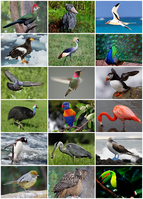
Photo from wikipedia
Abstract Better understanding of the mechanisms structuring ecological communities is not only a long-term theoretical pursuit in ecology but also critical for biodiversity conservation. Here, we used two complementary approaches… Click to show full abstract
Abstract Better understanding of the mechanisms structuring ecological communities is not only a long-term theoretical pursuit in ecology but also critical for biodiversity conservation. Here, we used two complementary approaches (β-diversity partitioning, and phylogenetic and functional null models) to explore the processes structuring wintering waterbird communities in the floodplain lakes of middle-lower Yangtze River (MLYR), China. We found that 1) neutral assembly might be the predominant process shaping the composition of wintering waterbird communities in MLYR; 2) compared to environmental factors, spatial variables, in particular those describing the large scale spatial structure among lakes, contributed more in explaining the functional and phylogenetic composition variations across the region, indicating dispersal constraints might strongly mediate neutral processes. The dispersal constraint could be imposed by movement barriers caused by anthropogenic landscape modification, site fidelity, or both; and 3) strong dispersal constraints could lead to competitive exclusion superimposed over neutrally assembly isolated communities, a hypothesis confirmed by the α- and β-null models. These findings provide strong support for the importance of conserving and improving ecological connectivity at the regional scale as well as habitat quality enhancement at lake scale.
Journal Title: Ecological Indicators
Year Published: 2020
Link to full text (if available)
Share on Social Media: Sign Up to like & get
recommendations!